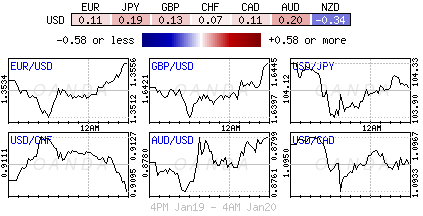The IMF yesterday maintained its October forecast for the Canadian economy to grow 2.2% this year, and this despite world growth improving. The static forecast has pushed Canada down the pecking order by one notch, to third amongst the G7 members. The US and the UK are expected to lead the way. It's supposedly a temporary blip, as the IMF expects Canada to regain that coveted number two-spot next year, predicting that the Canadian economy will grown by 2.4%.
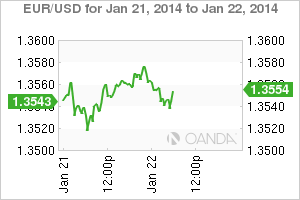 EUR/USD" title="EUR/USD" align="bottom" border="0" height="200" width="300">
EUR/USD" title="EUR/USD" align="bottom" border="0" height="200" width="300">
In Q4 last year, the IMF maintained that the Bank of Canada's monetary policy remained "appropriate," and it expected "gradual" tightening to begin in the early part of 2015. That prediction may be a tad aggressive as low inflation has become a matter of concern for Governor Poloz at the BoC. CPI in Canada has remained below that psychological 2% inflation benchmark for a year-and-a-half. Last November the governor happened to drop the BoC easing bias that was inserted 12-months prior by the current BoE head Mark Carney. The long held rate hike omission has allowed the currency to free-fall to a new 52-week low against its largest trading partner, the USD. On the crosses, it too has suffered, but obviously not to the same extent as with its closest neighbor.
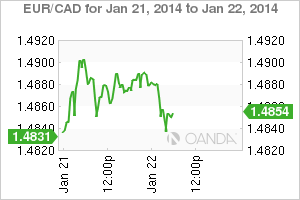 EUR/CAD" title="EUR/CAD" align="bottom" border="0" height="200" width="300">
EUR/CAD" title="EUR/CAD" align="bottom" border="0" height="200" width="300">
Later this morning the BoC is widely expected to keep its policy rate steady at 1%. The real question is whether policy makers are willing to keep their neutral bias or become more dovish. The 6% depreciation outright since the omission in Q4 would suggest that the currency has already priced in a strong percentage of "dovishness." Policy makers would be the first to admit that the weak CAD is already benefiting various sectors of the Canadian economy. If so, there really is no need for the BoC to rush out and change their stance to an easing bias just yet. Under this scenario, it would likely benefit the CAD bulls, temporarily at least, as a BoC absence should encourage some short CAD covering. The streets majority expects the BoC to maintain the same tone.
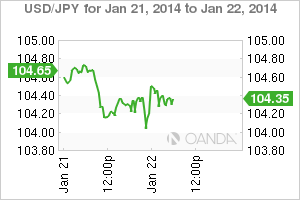 USD/JPY" title="USD/JPY" align="bottom" border="0" height="200" width="300">
USD/JPY" title="USD/JPY" align="bottom" border="0" height="200" width="300">
Governor Kuroda at the Bank of Japan kept monetary policy steady overnight and maintained its upbeat consumer inflation forecasts, encouraged by signs that a broadening economic recovery may encourage firms into spending more on wages and investment. As widely expected, the BOJ voted unanimously to maintain its pledge of increasing base money, or cash and deposits at the central bank, at an annual pace of ¥60-70 trillion. With the BoJ standing pat on policy initially had JPY strengthening and the Nikkei falling, but a slight downgrade of the 2014 forecast, and expectations that CPI at 1.9% rather than 2% in 2015 was capable of reversing some of the JPY initial strength outright due to the possibility of further policy easing eventually coming down the pipeline.
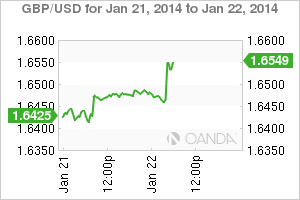 GBP/USD" title="GBP/USD" align="bottom" border="0" height="200" width="300">
GBP/USD" title="GBP/USD" align="bottom" border="0" height="200" width="300">
This morning's MPC minutes for Jan 8-9th revealed that the BoE officials agreed this month to keep the UK's central bank interest rate at a record low even after the unemployment reaches their 7% goal. Officials see no "immediate need to raise the Bank rate, even if the 7% unemployment threshold were to be reached any time soon." When its time to raise rates, MPC members agreed it would only be appropriate to raise the central bank's main interest rate "gradually." Carney and his fellow members have misjudged the pace of employment. A faster than expected UK recovery has meant that unemployment has fallen far quicker than policy makers anticipated. This morning's UK jobless numbers averaged 7.1% in the three-months to last November, and just above the original threshold level that Governor Carney indicated that UK were to hike. However, the UK's quickening has been accompanied by the "cooling" inflation – this has allowed Carney and company to ease their foot off the higher rate pedal and maintain there easy money stance.
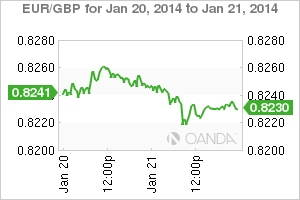 EUR/GBP" title="EUR/GBP" align="bottom" border="0" height="200" width="300">
EUR/GBP" title="EUR/GBP" align="bottom" border="0" height="200" width="300">
Investors diverging rate outlook happens to have the 18-member single currency trading at fresh one-year low against the pound today. If you set the hawkish BoE minutes from today, up against the dovish January ECB press conference, one finds reasons enough to favor the pound. From a technical stand point, 0.8160 has been a long time chosen target point for any techie, if and when breached it certainly opens a direct path to last years EUR/GBP low of 0.8087.